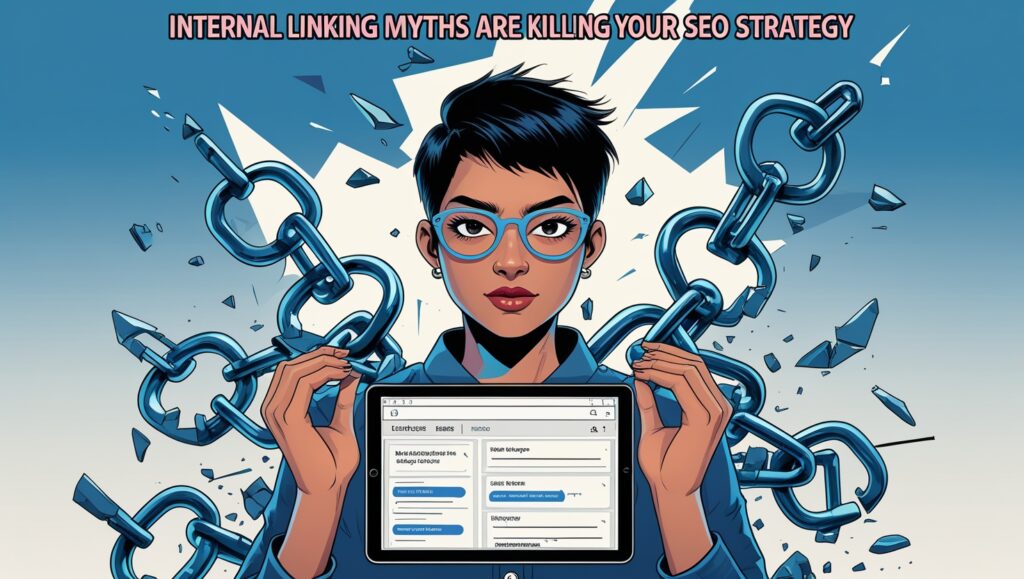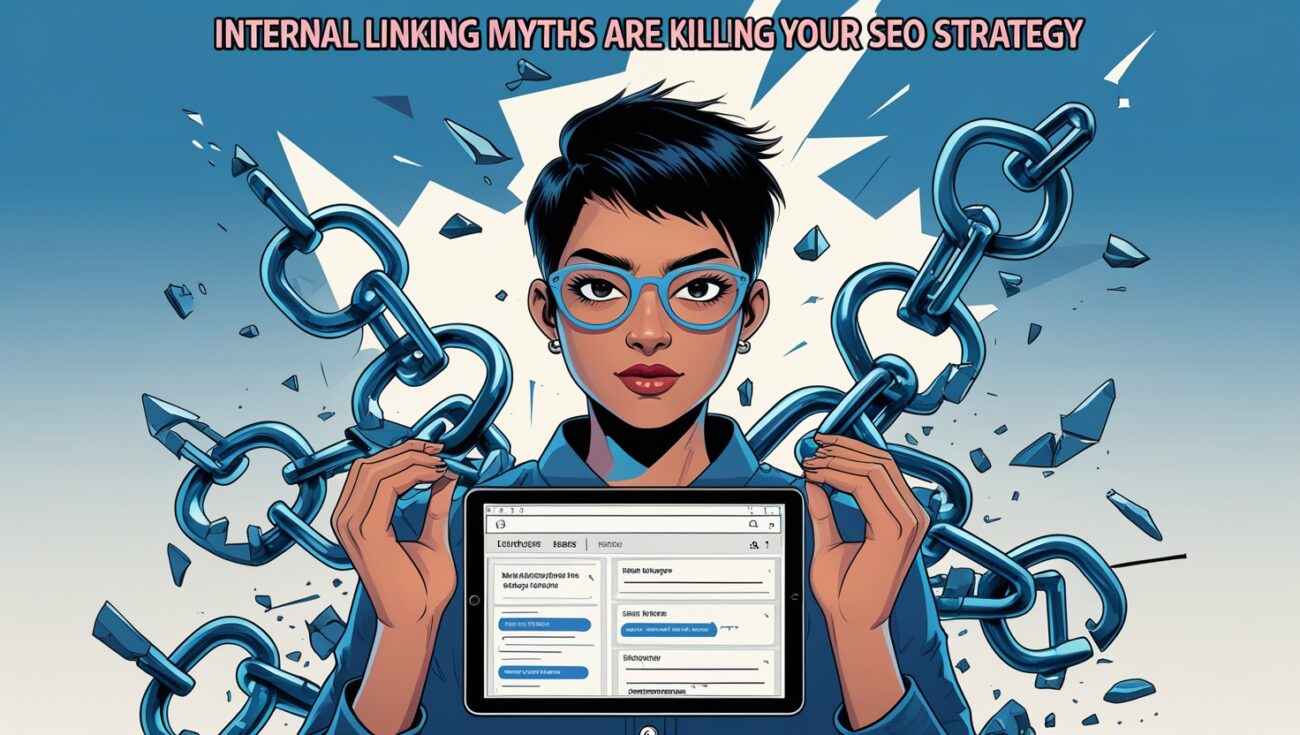Internal Linking Myths That Are Killing Your SEO Strategy
For a long time, I thought I was an expert on internal linking. I’d read a few articles, implemented a few strategies, and assumed I was doing it right. But when my rankings started to plateau, I realized that some of the advice I had followed was actually hurting my website, not helping it.

Table of Contents
There are countless myths about internal linking floating around the internet, and following them can not only waste your time but can actively harm your SEO. This guide is dedicated to correcting these common mistakes. If you’re ready to stop guessing and start building a website that’s optimized to rank, it’s time to debunk these myths.
Myth #1: Quantity Over Quality
- The Myth: You need to add as many internal links as possible to your pages to pass authority and help with SEO.
- The Truth: This is one of the most dangerous myths in SEO. A page filled with dozens of links is a confusing mess for users and for Google’s bots. It signals a poor website structure and can be seen as spammy. The truth is that a few high-quality, relevant, and contextual internal links are far more powerful than dozens of generic, low-quality ones. Focus on relevance, not quantity.
Myth #2: Keyword Stuffing in Anchor Text
- The Myth: You should use the exact same keyword in your anchor text every single time you link to a specific page.
- The Truth: Google is smart. An unnatural number of exact-match anchor text links to a page can look spammy and even trigger a penalty. The truth is that you should use a variety of relevant keywords, synonyms, and long-tail phrases in your anchor text. For example, if you’re linking to an article about “best running shoes,” you can use anchor text like “top running shoes,” “our shoe review guide,” or “find your next running shoe.”
Myth #3: You Don’t Need to Link to Old Posts
- The Myth: When you publish a new article, you only need to link from it to other pages. You don’t need to go back and link from old posts to your new content.
- The Truth: This is one of the biggest missed opportunities in SEO. A strategic internal link from an old, authoritative page is one of the most powerful ways to give a new article a ranking boost. A tool can help you find all of your old pages that are perfect for linking to your new content.
Myth #4: It’s a One-Time Fix
- The Myth: You only need to audit your internal links once. Once you’ve fixed all your broken links and orphaned pages, you’re good to go.
- The Truth: A website is a living, breathing thing. New broken links can pop up when you delete a page, and new internal linking opportunities arise every time you publish new content. You need to consistently audit your website for these issues to ensure your website structure stays healthy. A tool can take the manual work out of your internal link audit.
The Tool That Corrects the Myths
Manually managing all of the above is a monumental task. How do you find all your old pages that are perfect for linking to new ones? How do you ensure you’re using the right anchor text? The truth is, you don’t. You need a tool to do it for you. Internal linking automation can scan your entire site and provide you with a clear, actionable list of every opportunity and issue, taking the guesswork out of the process. Ready to stop guessing and start building a high-ranking website today? Discover how Linkbot can help you.
Conclusion: Get on the Right Track
By debunking these common myths, you can stop making crucial mistakes that are hurting your SEO strategy. A well-maintained, strategically linked website is the foundation of a high-ranking website. It’s time to get on the right track and build a powerful website that Google loves.
My journey taught me that a major mistake is seeing SEO as a mystery. By implementing a smart, corrective approach to my website, I made the mental shift from being a spectator to an active participant in my website’s success. This simple realization took the overwhelm out of SEO and turned it into a series of logical, manageable steps that I could control.
The long-term, compounding effect of fixing these mistakes is what makes it so powerful. Each time you add a thoughtful, relevant link, you are not just performing a task; you are building your website’s authority, one link at a time. These small, consistent improvements add up to a significant competitive advantage over the long term, making your website an increasingly powerful asset.
I can say from personal experience that there is a special kind of satisfaction that comes from seeing a direct correlation between a new link and a ranking boost. It’s the feeling of taking a tangled mess and organizing it into a clean, logical network. The result is a website that just feels better to navigate, for both users and the people managing it.
A clean internal link profile also has a huge impact on your website’s overall trustworthiness and authority. When a user or a search engine bot lands on your page and sees a clear network of interconnected, relevant articles, it signals that you are a serious, comprehensive resource on the topic. This kind of professional organization is exactly what Google looks for.
The most important part of this foundational skill is building a consistent habit of linking. It’s not about a single audit and then forgetting about it. A good website is a living thing, and it needs regular maintenance to ensure your internal links stay clean, which is a key part of long-term SEO success.
I felt like I was finally in the driver’s seat of my SEO. For years, I had relied on external factors, which felt like I was giving up control of my SEO destiny. But by mastering a simple task like building my internal links, I was proactively building my site’s authority from the inside out, on my own terms, which was an empowering and exciting feeling.
By implementing a strategy that serves both SEO and conversions, you are also directly addressing Google’s E-E-A-T framework. You are demonstrating expertise by creating topical clusters, you are showing authority by linking from strong pages, and you are providing a better user experience, which is a key part of what Google looks for in a trustworthy website.
I’ll never forget the first time I applied my new internal link strategy to a page that was struggling to rank, and it shot up in the search results almost overnight. This was my “aha” moment. I realized that a strategic, well-placed link from a high-authority page was far more powerful than I ever thought possible.
One of the greatest benefits I got from using an automated tool to manage my link profile was the “to-do” list it provided. Instead of being overwhelmed by the sheer size of my website, the tool gave me a prioritized, actionable list of fixes to make. It transformed a monumental, frustrating task into a series of manageable steps that I could tackle in just minutes.
It’s crucial to understand the difference between a simple, generic link and one that’s part of a strategic, mapped plan. A simple link is a one-off connection. A link that’s part of a plan is a purposeful part of a larger network, designed to pass authority and guide a user. The latter is far more powerful.
Ultimately, mastering internal linking is a simple but powerful strategy that transforms a website’s foundation. It’s a low-cost, high-impact fix that can instantly improve your site’s health and SEO performance. It’s the kind of foundational SEO work that every website owner should prioritize.
My final piece of advice is to not be intimidated. Don’t worry about the high cost of manual labor; just focus on making your website a better place for your readers. You will be amazed at the progress you make and the results you can achieve.

